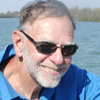The National Museum of Nuclear Science & History presides in isolation over a barren field half a dozen blocks south of Eubank Boulevard in Albuquerque. On each side of the gray, utilitarian building a rocket stands guard. Behind the building a score of military aircraft and missiles fill a 30-acre dirt lot. At the entrance to the museum building, the only ornament is a huge model of a beryllium atom—missing several of its protons and neutrons, which blew away in the high wind that regularly sweeps through the area.
Inside the entrance of the 30,000-square-foot federally funded museum I meet Robert Stearley, uniformed in a brown vest decorated with the insignia of the famous programs and organizations he has been involved with. Now a part-time volunteer guide at the museum, he involuntarily retired from his part-time job as mayor of Edgewood and voluntarily retired after 40 years as an administrator at Sandia National Laboratories. Stearley has agreed to conduct me on a personal tour of the museum that, despite considerable frustration, he is hoping to help improve, something the museum is badly in need of. He intersperses his description of the exhibits with personal anecdotes about the weapons systems he helped create, design and test, anecdotes that breathe life into a departed era.
Although there are small bright corners devoted to children’s activities, nuclear energy and nuclear medicine, the bulk of the exhibits, both inside and outside illustrate a unique period in American history—the half a century between 1940 and 1990 when war was the mission of the nation, when the United States was a military power, first and last. During at least parts of this period, encompassing World War II, the Korean conflict, the Vietnam War and the Cold War, the United States spent more on the military that all other countries combined, had an economy larger that the rest of world combined and devoted two-thirds of its budget to military activities. It was a period when there were sharply defined enemies, Germany and Japan and the Soviet Union, and many Americans felt their very survival was at stake, their way of life ready to implode at the push of a button.
This period, unlike anything seen before or since, is the real subject of the charts, weapons, illustrations, artifacts and signs at the National Museum of Nuclear Science & History, as well as a partial explanation for its almost complete silence on developments of the past quarter-century.
According to the museum’s web site, “The featured exhibits at the National Museum of Nuclear Science & History provide an objective, accessible window into the past, present, and future of nuclear science.” The objectivity is certainly open to question, but what is not discussable is the temporal perspective. “There is nothing at all about the present or the future,” Stearely states flatly.
As a museum focused on a special period in the past, it seems to be a kind of mausoleum, a memorial to the military past. And as such, a visit to this museum is as good a way as any to mark the end of an era. My visit occurred as the Pentagon and the Department of Energy were preparing to send out letters to nearly 3,000 civilian employees in Albuquerque notifying them they would go on furlough—taking a mandatory unpaid day off every week until at least the new fiscal year begins Oct. 1. No one I know is holding his breath for the furloughs to end then, either, while almost everybody is bracing for further cutbacks in a facility that has laid at the heart of American military might since the 1940s.
A museum can do one of two things. It can link the past to the present, using the linkage to explain both; or it can display the past as an isolated and remote artifact of time, a dead era.
Nothing makes the coming end of America's, and Albuquerque's, nuclear era as clear as a visit to the museum that was created by Congress to honor its past.



Responses to “Our national nuclear mausoleum”